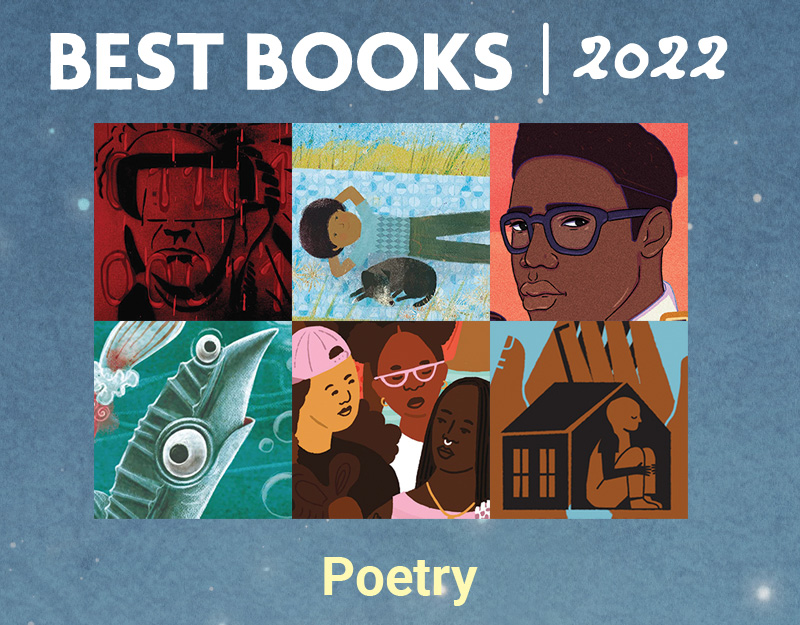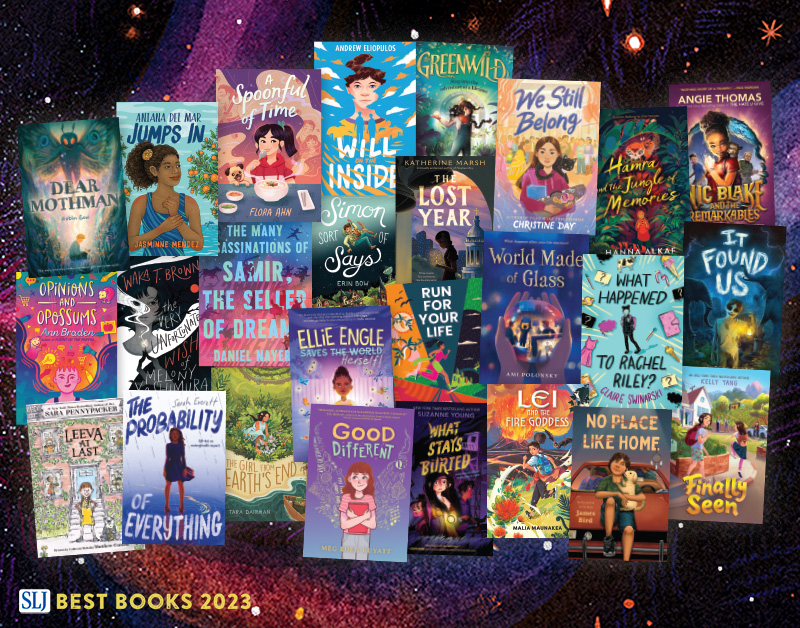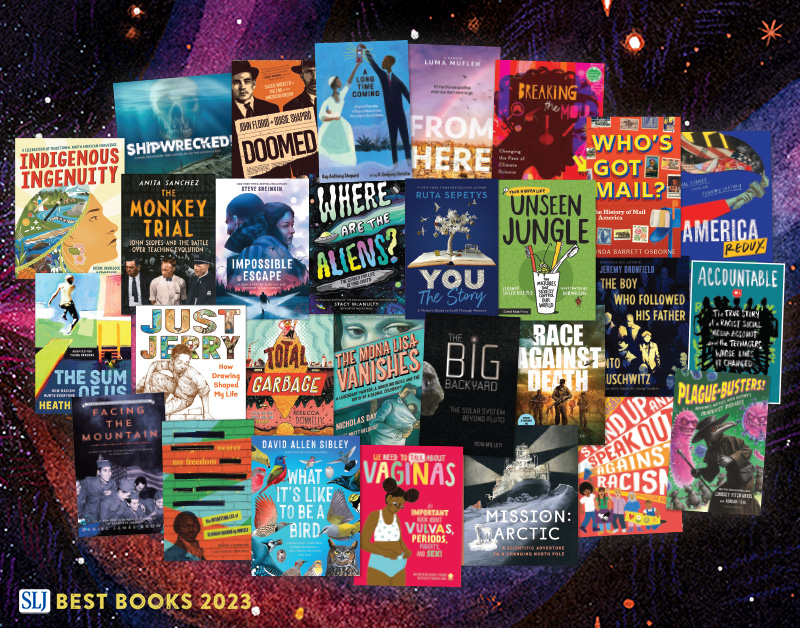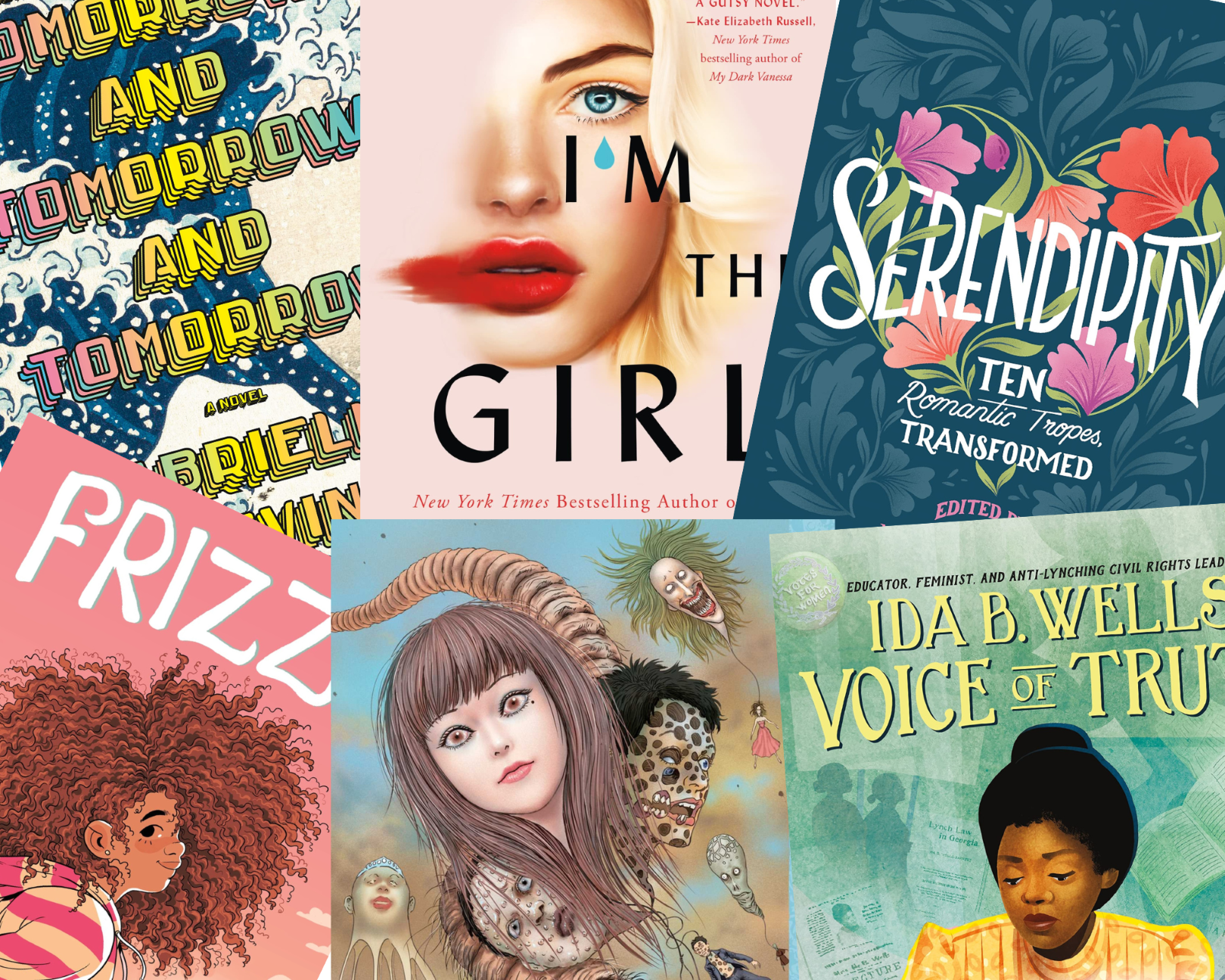Post-Orbis Pictus Nonfiction Musings
Imagine having hundreds of nonfiction books arrive on your doorstep. A teacher’s dream come true, right? When you’re a member of NCTE’s Orbis Pictus Committee, you are living the dream as you unpack box after box of titles, ranging in audience from preschool to young adult.
The NCTE book award committees are somewhat unique in that they offer members three-year terms. In becoming chair of Orbis Pictus, my overall tenure on the committee was extended a year, so I’m now heading into my fourth and final year. After the Thanksgiving holiday, I clear my bookshelf in preparation for the winter arrivals. The reading never really stops, though it does slow down a bit in the early months of the new year.
ADVERTISEMENT
ADVERTISEMENT
Over the past weekend, I sorted my books into piles, determining which ones to keep and which ones to donate to classrooms, keeping particular teachers, readers, and topics in mind. I lamented the excellent books that did not make the list and the ones that were beyond the scope of the award. Because Orbis Pictus focuses on books that can play a role in classroom life K-8, there are many excellent nonfiction books that fall outside of that age range or that don’t offer a range of teaching possibilities. Some books are just “too young adult” for us to consider, given the focus on K-8 learning. Still others are marvelous books for a range of readers, but we don’t see the books as having a significant role, let alone versatile roles, in language arts, science, social studies, or integrated arts curriculum K-8.
Moving all my stacks led me to think about the attributes of recent nonfiction. What follows are some observations from a year of reading.
Bibliographies and Back Matter
 Anecdotally, I think even more nonfiction books were published with bibliographies. This is a good thing! However, there are still too many wonderful books that don’t include a bibliography or source notes. This is not a good thing. Many of these books may still get starred reviews or end up on end of year “best of” lists. Great books that do interesting things get published without bibliographies. However, our award criteria requires that the information in the book be verifiable. Moreover, as literacy educators, informational literacy falls under our purview (an obligation we share with our school library colleagues). My message to publishers: please continue (and expand!) the trend towards greater transparency of source materials. Young people use nonfiction books as mentor texts. Adults need to model informational literacy responsibly. This is more important than ever.
Anecdotally, I think even more nonfiction books were published with bibliographies. This is a good thing! However, there are still too many wonderful books that don’t include a bibliography or source notes. This is not a good thing. Many of these books may still get starred reviews or end up on end of year “best of” lists. Great books that do interesting things get published without bibliographies. However, our award criteria requires that the information in the book be verifiable. Moreover, as literacy educators, informational literacy falls under our purview (an obligation we share with our school library colleagues). My message to publishers: please continue (and expand!) the trend towards greater transparency of source materials. Young people use nonfiction books as mentor texts. Adults need to model informational literacy responsibly. This is more important than ever.
While bibliographies and source notes are important, author’s and illustrator’s notes are always the most fascinating part of the back matter for me. This year, I think there were some really extraordinary author’s notes and illustrator’s notes across a wider range of books. Three books stand out for their extensive back matter.
Jason Chin’s extensive conversation about his research in Grand Canyon is a real game-changer, particularly for illustrators of nonfiction. Exactly how accurate do illustrations have to be in order to be nonfiction? In his back matter, Chin makes it clear to his readers where the scientific research ends and his own imagination begins. The Music of Life, illustrated by Marjorie Priceman, extends and expands readers’ understanding; not only does she source the information by each two-page spread, but she sends readers to her website to listen to music and understand the ways in which volume impacts mood.
 For high school readers, the back matter in Eyes of the World: Robert Capa, Gerda Taro, and the Invention of Modern Photojournalism is artful, informative, and extensive at forty pages, elevating back matter to an art form in and of itself. Authors Marc Aronson and Marina Budhos (in the interest of full disclosure, Marc and I have collaborated on a range of projects over the years) use the back matter to extend content, provide context, and challenge interpretation. But perhaps the most important elements of the back matter are the “How We Came to Write this Book,” in which both authors articulate their passion for and interest in the subject, and “Collaboration,” in which they talk about the ways in which they collaborated as researchers and writers. In this way, the authors not only demonstrate how the back matter can deepen reader’s knowledge of the content and the differing perspectives on the content; they model how to harness the artistic and academic potential of collaborative work.
For high school readers, the back matter in Eyes of the World: Robert Capa, Gerda Taro, and the Invention of Modern Photojournalism is artful, informative, and extensive at forty pages, elevating back matter to an art form in and of itself. Authors Marc Aronson and Marina Budhos (in the interest of full disclosure, Marc and I have collaborated on a range of projects over the years) use the back matter to extend content, provide context, and challenge interpretation. But perhaps the most important elements of the back matter are the “How We Came to Write this Book,” in which both authors articulate their passion for and interest in the subject, and “Collaboration,” in which they talk about the ways in which they collaborated as researchers and writers. In this way, the authors not only demonstrate how the back matter can deepen reader’s knowledge of the content and the differing perspectives on the content; they model how to harness the artistic and academic potential of collaborative work.
 While I think all nonfiction books need to cite sources in the back matter, they don’t all require extensive back matter. Authors and illustrators can use a little bit of space to convey a great deal. Two books on the same topic come to mind: Shark Lady: The True Story of How Eugenie Clark Became the Ocean’s Most Fearless Scientist written by Jess Keating and illustrated by Marta Alvarez Miguens, and If Sharks Disappeared, written and illustrated by Lily Williams. Both books dispel the stereotype of the dangerous shark, and both books have fairly short and simple author’s notes that share the impetus for writing the book as well as the author’s consideration of how to convey the information in a way that would read her audience. Additionally,
While I think all nonfiction books need to cite sources in the back matter, they don’t all require extensive back matter. Authors and illustrators can use a little bit of space to convey a great deal. Two books on the same topic come to mind: Shark Lady: The True Story of How Eugenie Clark Became the Ocean’s Most Fearless Scientist written by Jess Keating and illustrated by Marta Alvarez Miguens, and If Sharks Disappeared, written and illustrated by Lily Williams. Both books dispel the stereotype of the dangerous shark, and both books have fairly short and simple author’s notes that share the impetus for writing the book as well as the author’s consideration of how to convey the information in a way that would read her audience. Additionally,  Chris Barton is economical in his informative and conversational author’s note for Dazzle Ships: World War I and the Art of Confusion, and uses his “For Further Reading” section to point the reader to his complete bibliography on his website.
Chris Barton is economical in his informative and conversational author’s note for Dazzle Ships: World War I and the Art of Confusion, and uses his “For Further Reading” section to point the reader to his complete bibliography on his website.
Pop-Up Nonfiction Pops Up a Notch
Pop-Up books are not just for preschoolers anymore! While this trend has been true for awhile, I was impressed this year with the ways in which some books used pop-ups, flaps, and pull-tabs to convey information or mimic natural processes for an intermediate and middle grade audience.
For example, the Dinosaur Timeline in Tom Adams and Josh Lewis’s A Day at the Dinosaur Museum has many fascinating pull-tabs. One particularly effective pull-tab demonstrates how continents changed from the Triassic to the Jurassic to the Cretaceous worlds. Lonely Planet Kids’ Incredible Cabinet of Wonders: 100 Little Doors to the Weird and Wonderful from the World’s Great Museums puts the child reader in the position of armchair traveler, and uses flaps to build inquiry and celebrate the museum concept. 
Jennie Maizel, Reed Martin, and Austin Tichnor’s Pop-Up Shakespeare utilizes both pop-ups and flaps to introduce readers to Shakespeare’s histories, comedies, tragedies, and romances. Using every inch of space, the book designers put information on the front and the backs of the pop-ups. Flaps also appear on both the flat pages and the pop-ups.
Though not a pop-up book, Thomas Hegbrook’s gorgeous A Moment in Time plays with the format and structure of the book. Depending on how you hold the book and whether or not you pull out the sections, readers can choose to read it continuously, like time itself, or in linear fashion, with a start and finish.
Given the many modalities in which we can now receive secondary information, it makes sense that nonfiction picture books are going to become even more multimodal in the future.
Fascinating Fiction
Increasingly, books defy genre. This is a wonderful thing! However, for a nonfiction award that emphasizes accuracy and authenticity, it is hard for us to consider books in the first person when the subject of the book is not also the writer. This does not make these books bad books, just not the right fit for the award.
ADVERTISEMENT
ADVERTISEMENT
For example, Tom Leonard’s Becoming Bach is a gorgeous book. The illustrations are stunning and the writing is powerful, particularly when Bach discusses patterns in the real world and in his music. However, the books is written in Bach’s first person perspective. As a teacher-educator, I guide my students, who are teachers, to present the text as historical fiction rather than biography for their K-12 students. Similarly, Tracy Nelson Maurer and Mircea Catusanu’s Noah Webster’s Fighting Words is a marvelously self-conscious picture book in which Noah Webster serves as editor. It’s hilarious, informative, and interesting. But because of the insertion of his perspective and point-of-view, it also becomes historical fiction rather than straight biography.
 Finally, Don Brown and Mike Perfit’s Older than Dirt: A Wild but True History of Earth is multigenre: part fiction, part nonfiction, in graphic format. It’s a meticulously sourced “kinda-sorta biography of Earth;” but since it is told from a groundhog’s perspective, it, too, is more fiction than nonfiction in terms of classification.
Finally, Don Brown and Mike Perfit’s Older than Dirt: A Wild but True History of Earth is multigenre: part fiction, part nonfiction, in graphic format. It’s a meticulously sourced “kinda-sorta biography of Earth;” but since it is told from a groundhog’s perspective, it, too, is more fiction than nonfiction in terms of classification.
These are well-written, well-sourced books that have many roles to play in the curriculum and the reading lives of young people. But from my perspective, they’re fiction.
Conclusion
Nonfiction books for young people keep getting better and better from my perspective. The respect authors and illustrators have for young people propels them forward. Editors and book designers working with authors and illustrators continue to push the boundaries between the covers. There were many, many excellent nonfiction books published in 2017.
Over the next two months, I’ll blog about some of our Orbis Pictus Honor and Recommended titles in our typical format. And, I’ll look forward to what 2018 provides. If you are interested in applying for membership to the Orbis Pictus Committee, applications are due on December 1st!
Filed under: Announcements, Biography & Memoirs, Fictionalized Biography, Nonfiction, Nonfiction Chapter Books, Nonfiction Picture Books
About Mary Ann Cappiello
Mary Ann is a professor of language and literacy at Lesley University. A former public school language arts and humanities teacher, she is a passionate advocate for and commentator on children’s books. Mary Ann is the co-author of Teaching with Text Sets (2013) and Teaching to Complexity (2015) and Text Sets in Action: Pathways Through Content Area Literacy (Stenhouse, 2021). She has been a guest on public radio and a consultant to public television. From 2015-2018, Mary Ann was a member of the National Council of Teachers of English's Orbis Pictus Award for Outstanding Nonfiction (K-8) Committee, serving two years as chair.
ADVERTISEMENT
ADVERTISEMENT
SLJ Blog Network
The Moral Dilemma of THE MONSTER AT THE END OF THIS BOOK
Cover Reveal and Q&A: The One and Only Googoosh with Azadeh Westergaard
Winnie-The-Pooh | Review
Parsing Religion in Public Schools
ADVERTISEMENT








Thank you for sharing a bit of your review process and rationale. It can help us all create better books for young readers.
Thanks, Melissa! Thanks for all that you do to connect so many of us nonfiction readers and writers.
Thank you for this fascinating article. I especially enjoyed your discussion of the hybrid books. I wish the people behind the Cook Prize chose only non-fiction instead of so many hybrid books which add an additional layer of complexity to the process.
Thanks, Barb! It’s such an interesting and important conversation as so many books become multi-genre in nature.
Thank you for this fantastic post, Mary Ann! As an editor who focuses primarily on nonficiton (and is more than a little obsessed with back matter), I found it fascinating, and I’ve been encouraging all of my authors to read this post as well.
Thanks, Carol! I appreciate your advocacy of both the article and back matter. There are so many exciting ways to harness the creative and intellectual decision-making of authors and illustrators, and model that for young people. In a world all too often reduced to tweets, the complexity of what gets included and excluded from the primary manuscript is that much more important to address with readers.